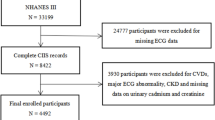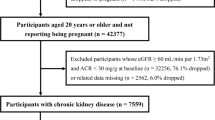Abstract
Cadmium (Cd) is a toxic heavy metal linked to an increased risk of cardiovascular disease (CVD). But the relationship between urinary Cd (U-Cd) and electrocardiographic subclinical myocardial injury (SC-MI) in older people is unclear. This study evaluated the connection between U-Cd and SC-MI in people who did not have CVD. The study involved 4269 participants from the National Health and Nutrition Examination Survey III(NHANES III) aged ≥ 50 years and had no history of CVD. The relationship between U-Cd and cardiac infarction/injury score (CIIS) was assessed by multivariable linear regression. Whether U-Cd and SC-MI were correlated was determined by multivariate logistic regression, restricted cubic spline, and subgroup analysis. There was a significant association between U-Cd and CIIS (β, 1.04, 95% confidence interval (CI): 0.39–1.69; P = 0.003) in the highest quartile and fully adjusted model. After adjusting for relevant confounders, multivariable logistic regression showed that participants in the highest quartile of U-Cd had a greater chance of having SC-MI than those in the first ( OR (95% CI), 1.37(1.13,1.66), P for trend = 0.003), and this relationship was especially strong among hypertensive participants. And a positive linear correlation between U-Cd and the prevalence of SC-MI was shown by restricted cubic spline analysis. U-Cd may be a novel risk element for SC-MI because it is independently and linearly linked to CIIS and SC-MI.




Similar content being viewed by others
Data availability
The National Health and Nutrition Examination Survey (NHANES) is an open-access resource, and data are available at https://www.cdc.gov/nchs/nhanes.
Abbreviations
- Cd :
-
Cadmium
- CVD :
-
Cardiovascular disease
- ASCVD :
-
Atherosclerotic cardiovascular disease
- AMI :
-
Acute myocardial infarction
- IHD :
-
Ischemic heart disease
- U-Cd :
-
Urinary cadmium
- SC-MI :
-
Subclinical myocardial injury
- CIIS :
-
Cardiac infarction/injury score
- CDC:
-
Centers for Disease Control and Prevention
- PIR :
-
Poverty income ratio
- SBP :
-
Systolic blood pressure
- DBP :
-
Diastolic blood pressure
- PR :
-
Pulse rate
- BMI :
-
Body mass index
- TC :
-
Total cholesterol
- HDL-C :
-
High-density lipoprotein cholesterol
- TG :
-
Triglycerides
- CRP :
-
C-reactive protein
- APOB :
-
Apolipoprotein B
- FIB :
-
Fibrinogen
- C-p :
-
C-peptide
- BUN :
-
Blood urea nitrogen
- UA :
-
Uric acid
- ROS :
-
Reactive oxygen species
- NADPH :
-
Nicotinamide adenine dinucleotide phosphate oxidase
- SE :
-
Standard error
- CI :
-
Confidence interval
- NHANES III :
-
National Health and Nutrition Examination Survey III
References
Afolabi OK, Oyewo EB, Adekunle AS et al (2012) Impaired lipid levels and inflammatory response in rats exposed to cadmium. EXCLI J 11:677–687
Afridi HI, Kazi TG, Kazi NG et al (2010) Evaluation of cadmium, lead, nickel and zinc status in biological samples of smokers and nonsmokers hypertensive patients. J Hum Hypertens 24(1):34–43
Ahmad MI, Chevli PA, Li Y et al (2018) Vitamin D deficiency and electrocardiographic subclinical myocardial injury: results from National Health and Nutrition Examination Survey-III. Clin Cardiol 41(11):1468–1473
Akesson A, Barregard L, Bergdahl IA et al (2014) Non-renal effects and the risk assessment of environmental cadmium exposure. Environ Health Perspect 122(5):431–438
Ali M, Li Y, O’Neal WT et al (2017) Tobacco exposure as determined by serum cotinine and subclinical myocardial injury in individuals free from cardiovascular disease. Am J Cardiol 120(7):1114–1117
Bilgen I, Oner G, Edremitlioglu M et al (2003) Involvement of cholinoceptors in cadmium-induced endothelial dysfunction. J Basic Clin Physiol Pharmacol 14(1):55–76
Brzóska MM, Kozłowska M, Rogalska J (2022) The beneficial impact of zinc supplementation on the vascular tissue of the abdominal aorta under repeated intoxication with cadmium: a study in an in vivo experimental model. Nutrients 14(19):4080. https://doi.org/10.3390/nu14194080
Chen C, Xun P, Tsinovoi C et al (2018) Urinary cadmium concentration and the risk of ischemic stroke. Neurology 91(4):e382–e391
Chen L, Sun Q, Peng S et al (2022) Associations of blood and urinary heavy metals with rheumatoid arthritis risk among adults in NHANES, 1999–2018. Chemosphere 289:133147
Chowdhury R, Ramond A, O’Keeffe LM et al (2018) Environmental toxic metal contaminants and risk of cardiovascular disease: systematic review and meta-analysis. BMJ 362:k3310
Dekker JM, Schouten EG, Pool J et al (1994) Cardiac Infarction Injury Score predicts cardiovascular mortality in apparently healthy men and women. Br Heart J 72(1):39–44
Domingo-Relloso A, Grau-Perez M, Briongos-Figuero L et al (2019) The association of urine metals and metal mixtures with cardiovascular incidence in an adult population from Spain: the Hortega Follow-Up Study. Int J Epidemiol 48(6):1839–1849
Everett CJ, Frithsen IL (2008) Association of urinary cadmium and myocardial infarction. Environ Res 106(2):284–286
Fagerberg B, Bergstrom G, Boren J et al (2012) Cadmium exposure is accompanied by increased prevalence and future growth of atherosclerotic plaques in 64-year-old women. J Intern Med 272(6):601–610
Fechner P, Damdimopoulou P, Gauglitz G (2011) Biosensors paving the way to understanding the interaction between cadmium and the estrogen receptor alpha. PLoS One 6(8):e23048
Florido R, Ndumele CE, Kwak L et al (2017) Physical activity, obesity, and subclinical myocardial damage. JACC Heart Fail 5(5):377–384
German C, Ahmad MI, Li Y et al (2020) Relations between physical activity, subclinical myocardial injury, and cardiovascular mortality in the general population. Am J Cardiol 125(2):205–209
Guallar E, Silbergeld EK, Navas-Acien A et al (2006) Confounding of the relation between homocysteine and peripheral arterial disease by lead, cadmium, and renal function. Am J Epidemiol 163(8):700–708
Guo X, Li N, Wang H et al (2022) Combined exposure to multiple metals on cardiovascular disease in NHANES under five statistical models. Environ Res 215(Pt 3):114435
Ivanova J, Gluhcheva Y, Arpadjan S et al (2014) Effects of cadmium and monensin on renal and cardiac functions of mice subjected to subacute cadmium intoxication. Interdiscip Toxicol 7(2):111–115
Kim DW, Ock J, Moon KW, Park CH (2022) Association between heavy metal exposure and dyslipidemia among Korean adults: from the Korean national environmental health survey, 2015-2017. Int J Environ Res Public Health 19(6):3181. https://doi.org/10.3390/ijerph19063181
Kluxen FM, Hofer N, Kretzschmar G et al (2012) Cadmium modulates expression of aryl hydrocarbon receptor-associated genes in rat uterus by interaction with the estrogen receptor. Arch Toxicol 86(4):591–601
Liu Y, Wu M, Xu J et al (2020) Association between triglyceride and glycose (TyG) index and subclinical myocardial injury. Nutr Metab Cardiovasc Dis 30(11):2072–2076
Navas-Acien A, Selvin E, Sharrett AR et al (2004) Lead, cadmium, smoking, and increased risk of peripheral arterial disease. Circulation 109(25):3196–3201
Navas-Acien A, Silbergeld EK, Sharrett R et al (2005) Metals in urine and peripheral arterial disease. Environ Health Perspect 113(2):164–169
Ndumele CE, Coresh J, Lazo M et al (2014) Obesity, subclinical myocardial injury, and incident heart failure. JACC Heart Fail 2(6):600–607
O’Neal WT, Shah AJ, Efird JT et al (2014) Subclinical myocardial injury identified by cardiac infarction/injury score and the risk of mortality in men and women free of cardiovascular disease. Am J Cardiol 114(7):1018–1023
Qu Y, Lv Y, Ji S et al (2022) Effect of exposures to mixtures of lead and various metals on hypertension, pre-hypertension, and blood pressure: a cross-sectional study from the China National Human Biomonitoring. Environ Pollut 299:118864
Rautaharju PM, Warren JW, Jain U et al (1981) Cardiac infarction injury score: an electrocardiographic coding scheme for ischemic heart disease. Circulation 64(2):249–256
Rubin J, Matsushita K, Ballantyne CM et al (2012) Chronic hyperglycemia and subclinical myocardial injury. J Am Coll Cardiol 59(5):484–489
Tellez-Plaza M, Guallar E, Fabsitz RR et al (2013) Cadmium exposure and incident peripheral arterial disease. Circ Cardiovasc Qual Outcomes 6(6):626–633
Tellez-Plaza M, Guallar E, Howard BV et al (2013) Cadmium exposure and incident cardiovascular disease. Epidemiology 24(3):421–429
Thapa S, Delhey L, Jin J et al (2018) Association between urinary cadmium and QRS|T angle among adults in the United States. J Occup Environ Med 60(8):e412–e415
Tinkov AA, Filippini T, Ajsuvakova OP et al (2018) Cadmium and atherosclerosis: a review of toxicological mechanisms and a meta-analysis of epidemiologic studies. Environ Res 162:240–260
Tulinska J, Masanova V, Liskova A et al (2020) Six-week inhalation of CdO nanoparticles in mice: the effects on immune response, oxidative stress, antioxidative defense, fibrotic response, and bones. Food Chem Toxicol 136:110954
Vallee A, Gabet A, Grave C et al (2020) Associations between urinary cadmium levels, blood pressure, and hypertension: the ESTEBAN survey. Environ Sci Pollut Res Int 27(10):10748–10756
van Domburg RT, Klootwijk P, Deckers JW et al (1998) The Cardiac Infarction Injury Score as a predictor for long-term mortality in survivors of a myocardial infarction. Eur Heart J 19(7):1034–1041
Vasim I, Ahmad MI, Mongraw-Chaffin M et al (2019) Association of obesity phenotypes with electrocardiographic subclinical myocardial injury in the general population. Clin Cardiol 42(3):373–378
Waits GS, O’Neal WT, Sandesara PB et al (2018) Association between low diastolic blood pressure and subclinical myocardial injury. Clin Res Cardiol 107(4):312–318
Wang Q, Wei S (2018) Cadmium affects blood pressure and negatively interacts with obesity: findings from NHANES 1999–2014. Sci Total Environ 643:270–276
Wang B, Li Y, Shao C et al (2012) Cadmium and its epigenetic effects. Curr Med Chem 19(16):2611–2620
Wang X, Mukherjee B, Park SK (2018) Associations of cumulative exposure to heavy metal mixtures with obesity and its comorbidities among U.S. adults in NHANES 2003–2014. Environ Int 121(Pt 1):683–694
Wang Z, Huang X, Li J et al (2022) Association between waist-hip ratio and subclinical myocardial injury in the general population: insights from the NHANES. Front Endocrinol (Lausanne) 13:975327
Xu C, Weng Z, Zhang L et al (2021) HDL cholesterol: a potential mediator of the association between urinary cadmium concentration and cardiovascular disease risk. Ecotoxicol Environ Saf 208:111433
Yang WY, Zhang ZY, Thijs L, Cauwenberghs N, Wei FF, Jacobs L, Luttun A, Verhamme P, Kuznetsova T, Nawrot TS, Staessen JA (2017) Left ventricular structure and function in relation to environmental exposure to lead and cadmium. J Am Heart Assoc 6(2):e004692. https://doi.org/10.1161/JAHA.116.004692
Yiu KH, Zhao CT, Chen Y et al (2013) Association of subclinical myocardial injury with arterial stiffness in patients with type 2 diabetes mellitus. Cardiovasc Diabetol 12:94
Zhu C, Wang B, Xiao L et al (2020) Mean platelet volume mediated the relationships between heavy metals exposure and atherosclerotic cardiovascular disease risk: A community-based study. Eur J Prev Cardiol 27(8):830–839
Author information
Authors and Affiliations
Contributions
Yu-Jie Wu and Si-Bo Wang: concept development, methodology, software, writing-original draft, visualization. Jia-Teng Sun, Ling-Feng Gu, Ze-Mu Wang, Bo Deng, and Hao Wang: writing-review and editing, data curation, validation. Lian-Sheng Wang: concept development, project management, editing, reviewing, and writing supervision.
Corresponding author
Ethics declarations
Ethics approval and consent to participate
All data were obtained from secondary sources and available publicly. No protocol approval was necessary.
Consent for publication
Not applicable. There was no individual-level data in our study.
Competing interests
The authors declare no competing interests.
Additional information
Responsible Editor: Lotfi Aleya
Publisher's note
Springer Nature remains neutral with regard to jurisdictional claims in published maps and institutional affiliations.
Supplementary Information
Below is the link to the electronic supplementary material.
Rights and permissions
Springer Nature or its licensor (e.g. a society or other partner) holds exclusive rights to this article under a publishing agreement with the author(s) or other rightsholder(s); author self-archiving of the accepted manuscript version of this article is solely governed by the terms of such publishing agreement and applicable law.
About this article
Cite this article
Wu, YJ., Wang, SB., Sun, JT. et al. Association between urinary cadmium level and subclinical myocardial injury in the general population without cardiovascular disease aged ≥ 50 years. Environ Sci Pollut Res 30, 77551–77559 (2023). https://doi.org/10.1007/s11356-023-27923-0
Received:
Accepted:
Published:
Issue Date:
DOI: https://doi.org/10.1007/s11356-023-27923-0




